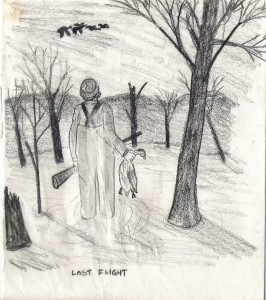Today’s Creekbank Blog Post is number 1500 in a long string of blog posts stretching back to June 2006.
You can trace them all back by scrolling our blog posts at www.creekbank.net
After you read “The Cardinal and Mr. Smith’s Plane,” we believe you’ll enjoy this story on YouTube as well as our Audio Podcast.
The Cardinal and Mr. Smith’s Plane
The bird crashed into the plate glass window. My friend and I approached where a red cardinal lay on the grass.
She said, “It’s dead.”
“Let’s watch for a while. I’ve seen birds knocked silly from a collision get up, wobble around, and fly off.”
We waited for several minutes.
It was evident this cardinal’s flying days were over.
He was D.O.A.
Dead on Arrival.
I took the bird home, and my young granddaughter joined me for a backyard bird funeral. Don’t laugh. I’ve officiated at many animal funerals, especially dog funerals.
As I recall, I cried at most of them.
Pondering the cardinal’s sudden death, I thought about this: he wasn’t eaten by a cat, starved to death during a harsh winter, or wasted away by disease.
Mr. Cardinal died doing what he loved best: flying.
* * *
Then, I recalled the story of James Smith, Jr. and his flight over Dry Creek.
In early December 2000, Jim Smith took off from an Austin, Texas, area airport, bound for Gainesville, Florida. He was flying to the manufacturer’s plant of his Team Tango experimental plane.
Mr. Smith, an experienced pilot, had retired from the military and later from school teaching. At age 73, he still enjoyed flying and adventure.
I’m sure he was proud of his plane.
Flying solo across the South.
Man, it sounds great.
The wind in his hair.
A contented smile on his face passed over the vast pine forests that cover Southwest Louisiana.
Then, something happened as he flew over my hometown of Dry Creek. Folks heard the plane’s engine sputtering as it came over low in the clouds.
A loud crash in Bundick Swamp followed this.
The next day, searchers found Mr. Smith’s body and his plane in Bundick Creek.
* * *
A few days later, I hiked to the crash site. The fuselage was buried in the creek, but there were no broken limbs along the bank. Evidently, the plane had plummeted straight down.
Bundick Creek is a very special stream in my life. It’s where I learned to swim and was the site of baptisms during my childhood. My Dad and I set trot lines along it, and it was always a good spot to crawl up on wood ducks.
As I sat on that Bundick sandbar looking at the wreckage of his plane, I wondered about this man named Jim Smith, whose life ended near the community I love.
I never met him, but I know I would’ve liked him, and I believe he would’ve liked a place called Dry Creek.
In the end, James A. Smith, Jr. was a man who lived life to the fullest, even to the end. He was doing exactly what he loved best- flying.
There are all kinds of ways to die at 73. Most of them involve a slow decline in health. That slow creeping death never touched Mr. Smith. His life didn’t end in a nursing home or in hospice.
The chances are slim that we’ll live and die doing what we were born to do.
Mr. Smith did, and so did the red cardinal. Flying.
Doing what they loved.
Two life lessons on doing what you love.
Mr. Smith did, and so did the red cardinal. They were flying.
Doing what they loved.
Two life lessons.
A plane flying low over Bundick Swamp in Dry Creek, Louisiana.
A red cardinal buried in my backyard.

Sketch: Curt Iles 1984
 Creekbank Stories Curt Iles, Storyteller
Creekbank Stories Curt Iles, Storyteller

